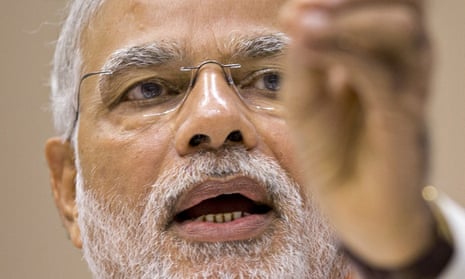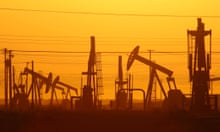India was the best place to put your money in 2014, and Russia the worst, according to an analysis of the thousands of investment funds sold to British small investors. Meanwhile, more conventional stay-at-home investors lost out as the FTSE 100 index of the UK’s biggest companies fell over the year.
Nine of the 10 top-performing funds of the year (out of a total of 3,057) had their money in Indian company shares, according to figures from investment data provider Trustnet.com. Lucky buyers of the Matthews Asia India fund have seen their money grow by 60% since 1 January, although with just £3.4m under management the fund is a minnow. The much larger Goldman Sachs India fund (£440m) and the Jupiter India fund (£300m) both gave their more numerous investors gains of just over 50% during the year.
This article includes content hosted on d26adhsj11a4c2.cloudfront.net. We ask for your permission before anything is loaded, as the provider may be using cookies and other technologies. To view this content, click 'Allow and continue'.
Meanwhile, the plunge in oil prices, combined with sanctions and a collapse in the rouble, have punished anyone with an investment in Russian or energy funds. Six of the bottom 10 funds are invested in Russia, although the wooden spoon goes to Schroders for its Global Small Cap Energy fund. The price of its two biggest holdings – Antares Energy and Faroe Petroleum – have slumped in recent months, leaving investors nursing losses of 51% over the year.
But the Schroders fund is not widely held by small investors. More of a worry are the Russia funds popular with buyers in recent years. The Neptune Russia & Greater Russia fund, which has £185m under management, is one of the Wealth 150 funds that brokerage Hargreaves Lansdown promotes to its army of small investors. It has collapsed in value by 42% since the start of the year, with its largest holding, a supermarket group Magnit, falling in value by a 10th in just the last week, while its big investments in Gazprom and Lukoil have collapsed by nearly a half over the past month.
Following the landslide victory of newly elected prime minister Narendra Modi, the government has been able to pursue an ambitious programme of much needed reforms
But in Mumbai, the financial capital of India, it has been party time. Surging economic growth and profit expectations have pushed the Bombay Stock Exchange index, the Sensex, almost on a straight line upwards across 2014. It started the year at 21,140, and this week was trading above 26,700 – a rise of 26%. Over the same period the FTSE 100 in the UK has fallen by 6% from 6,749, slipping below 6,300 this week.
The International Monetary Fund suggests India’s economy has turned a corner after a slowdown following the credit crunch, forecasting GDP growth of 5.6% this year and 6.4% in 2015. Meanwhile PwC predicts India will be the third largest economy by 2030, behind the US and China. It currently sits in 10th place. Stocks such as ICICI Bank, held in Jupiter’s India fund, have jumped as much as 70% over the year.
Can the boom in Indian shares continue? Stockbrokers Brewin Dolphin thinks so, making it one of their fund picks for 2015. “We have become increasingly positive on the outlook for the Indian market. Following the landslide victory of newly elected prime minister Narendra Modi, the government has been able to pursue an ambitious programme of much needed reforms. India is one of the few emerging markets where the potential growth rate is moving higher. In 2016 we could even see India growing faster than China,” said Ben Gutteridge, Brewin Dolphin’s head of fund research. He is recommending a relatively unknown fund, Ocean Dial Gateway, for next year.
But Hargreaves Lansdown analyst Laith Khalaf underlines the risks. “Expectations for Modi are already very high, leaving considerable scope for disappointment. Government subsidies will be a thorny issue for Modi to address. These subsidies keep fuel, food and fertiliser prices down and affordable for the population, but they also cost the government huge amounts of money and stifle modernisation in these industries. Perhaps one particularly unsavoury risk is the huge political capital invested in one individual in the form of Modi, in a country noted for political assassinations.”
He says if you are keen to invest, he likes the Jupiter India fund, or First State Asia Pacific Leaders, which is 20% invested in India.
Will investors be brave or foolhardy buying Russian stocks at what look like bargain-basement prices, or will the stocks continue to slide? If the oil price remains at $60 a barrel, the Russian economy could contract by around 4-5% next year. Fidelity investment director Tom Stephenson says: “Russia is walking a tightrope. It has to cap inflation and put a floor under the rouble but doing so risks a painfully hard landing for an economy that is desperately vulnerable to a falling oil price and finds itself squeezed by sanctions over its continuing involvement in the war in eastern Ukraine.
“Russia imports pretty much everything except energy so the weakness of its currency risks prices spiralling out of control. It is not just the currency which is under the cosh. The Russian stock market has also halved this year and it has lost around two thirds of its value over the past three years. Since peaking just before the financial crisis it has fallen by three quarters.”
A recovery in Russia will only come if the oil price rebounds, Fidelity warns – and there is no evidence of that yet.
This article includes content hosted on d26adhsj11a4c2.cloudfront.net. We ask for your permission before anything is loaded, as the provider may be using cookies and other technologies. To view this content, click 'Allow and continue'.
But for most British investors, what counts is how shares on the London Stock Exchange perform. Normally we would ask the “experts” where they reckon the FTSE will be this time next year. But instead we went back to their predictions in late 2013 – and found most were a long way off the mark.
Citigroup, which styles itself as “the leading global bank” told investors in September last year that the FTSE would hit a record high of 8,000 by the end of 2014, helped by a recovery in Europe and strengthening bank balance sheets. Economic forecasters Capital Economics also confidently predicted a rise in the index to 7,500. Instead, the FTSE fell over the year – partly as growth in Europe slowed and banks continued to reveal balance sheet problems. One of the more hilarious predictions for 2014 was by the “Market Oracle” which said gold would “slingshot” to $2,500 an ounce. Instead it continued to decline. But small investors have no better record than the highly paid “experts”. A poll of 1,000 investors by Barclays Stockbrokers in December 2013 found that nine out of 10 believed the FTSE would end higher in 2014, with one in four expecting it to move above its all-time high.
The best and worst FTSE shares
The collapse in Tesco’s share price made it the second-worst performer in the FTSE 100 in 2014 – beaten to bottom place only by an oil exploration and production company hammered by the petroleum price fall .
Tesco’s saw a 51% fall since 1 January, wrong-footing even legendary bargain hunter Warren Buffett. He sold down his holdings in October, admitting he had made a “huge mistake”. But at least he offloaded shares – since when, Tesco has sunk further in the wake of a second profits warning.
The best-performing FTSE 100 stock of 2014 was Shire, a pharmaceutical company at the centre of a controversial £34bn takeover bid by US firm AbbVie. Its shares are up 57%, helped by a near-£1bn windfall paid by AbbVie after the deal failed.
Water company United Utilites, which serves 7m households in the north-west, saw its share price rise 35%. They surged again after the water regulator permitted more price rises set at RPI, currently 2%, compared to wage increases which are averaging around 1%. Overall, the price soared from 488p five years ago to 920p this week.
But the biggest risers and fallers in the FTSE 100 since January 1 fail to take into account the companies leaving or joining the index. Carphone Warehouse merged with Dixons (owners of Currys and PC World) in September and, after what its chief executive called a “barnstorming” performance, has seen its share rise sharply. Investors are sitting on a gain of more than 60% over the year. But it’s a very different story for Coca-Cola. Its European bottling operation joined the FTSE 100 in September – only for the fizz to flatten almost immediately. From a high of £18 they now trade for a little below £12.50.






Comments (…)
Sign in or create your Guardian account to join the discussion